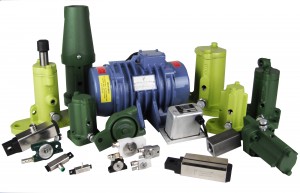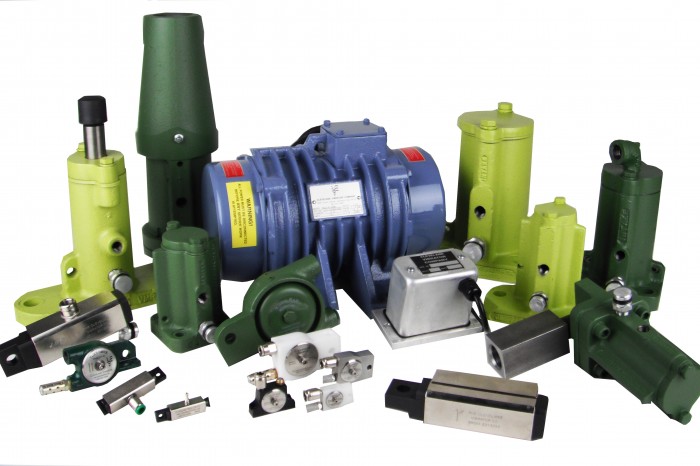I’ve been told that my last blog regarding the importance of wall thickness when utilizing external industrial vibrators for bins or hoppers seems to have struck a chord. I plan to expand on that blog by providing some recommendations for sizing external vibrators since I merely referred to a vibrator with proper force previously – and you just may have been afraid to ask!
Essentially, we need to apply enough external force to the wall of the bin or hopper to assist gravity in getting material to flow. While I previously stressed properly flexing of the wall to get the material to flow, we still need to determine the correct amount of force to apply based on the configuration of the hopper as well as the bulk density and flowability of the material. Since we are able to produce our own fabricated equipment based on our expert experience through the years, we know that these variables are crucial to proper use of industrial vibration applications.
Our first task is to determine the weight of the material in the sloped wall (cone) section. Unless this is provided, we need to calculate the volume of the cone. The following is a link to our sizing guide which provides formulas on page 2 for calculating the volume of square/rectangular hoppers and circular hoppers: http://www.clevelandvibrator.com/images/Documents/CVCsizingguide_11092012.pdf
Once we know the volume, make sure it’s in, or convert it to cubic feet, and then simply multiply it by the bulk density of the material which needs to be in pounds/cubic feet to give you the pounds of material in the cone. Most vibrator companies offer charts where they recommend specific vibrators based on the material in the cone. You can once again refer to our sizing guide above for our recommendations. For those with inquiring minds, our charts are based on a ratio of 1.0 pound of force for every 10 pounds of material in the cone. You should consider multiple vibrators where you need to limit the size of the vibrator due to the wall thickness or the physical size of the hopper dictates it.
Now for the fun part, which vibrator type should you select? I am proponent of linear vibration for typical hopper applications. Most folks are aware that hammers are used to help promote flow in hoppers. While they can work, it leaves you open for medical issues and can lead to damage to the hopper. Air piston vibrators provide linear vibration with styles that impact, somewhat replicating a hammer hit, but at much higher frequencies. I recommend Cleveland Vibrator Co.’s Single Impact Air Knocker Vibrators where an air powered piston impacts one stroke at a time for poor flowing materials. This style operates in a cycle, most commonly in conjunction with a timer so that the piston impacts, returns and is held until it receives a signal for the next impact. I then suggest the more common impact vibrators if the material flows more freely. This style has the piston impacting continuously at a high frequency when activated and can be very effective. When noise is a consideration, a third style of air piston vibrator, Cleveland Vibrator’s VMSAC or VMRAC vibrators can be utilized. These Industrial Vibrators are air-cushioned, where the piston does not impact, resulting in lower noise volumes. These run quieter since there is no metal to metal impacting, but consequently they are less powerful, so you typically need a larger piston than those in a similarly sized impact vibrator, for the same application.
When linear vibration is not necessary or desired, Cleveland Vibrator has other options available such as Pneumatic Ball Vibrators, our Turbomite Series containing pneumatic turbine vibrators, and lastly our “rotary” air powered vibrators. These vibrators produce centrifugal force by rotating an eccentric weight. They typically provide a very high frequency. Only the turbine vibrator in this group has more acceptable noise levels. I generally suggest these style vibrators for smaller hoppers where the material is very free flowing.
When air is not available or desirable, our Rotary Electric Industrial Vibrators can be utilized. Electromagnetic vibrators produce linear force at a high frequency, so I usually reserve them for small, thinner walled hoppers. Rotary electric vibrators produce a centrifugal force, but I believe they are better suited for hopper applications where the material flow is good. These vibrators produce the least amount of noise and are available in several voltages. They are also available with different frequencies. The higher frequencies like 3600 RPM are best for heavier density materials like sand while a lower frequency like 1800 RPM might be better suited for light densities as they produce a greater stroke. None of these vibrators, with the possible exception of the single impactors, should ever be run continuously for any great length of time. The reason is that if the flow of material is ever impeded, the external vibration could actually worsen the condition by packing the material more tightly in the cone.
So you no longer need to ask. You now have some ideas on which vibrators to consider and the amount of force you will need to apply. Don’t forget that you still need to flex the wall to promote material flow and follow good welding practices combined with proper wall thickness recommendations to prevent cracking.
Still have more questions? We are here to help! Simply click here for more information.
 Cleveland Vibrator Co.’s Complete Industrial Vibrator Line
Cleveland Vibrator Co.’s Complete Industrial Vibrator Line

Jack Steinbuch has been with The Cleveland Vibrator Company for over 36 years accumulatively. He has previous experience in the manufacturing industry as a Senior Application Engineer and has worn many hats on our team in sales and managerial capacities. Now, he’s in the position of General Sales Manager. With a BSCE from The University of Toledo, he is an expert in the realm of sizing vibratory screeners and feeders, and sizing vibratory drives for tables and other vibratory equipment. Understanding that customer service is crucial, Jack believes it is important to provide the proper product for every application, even if it happens to not be supplied by The Cleveland Vibrator Company.
In his off-hours, you can find Jack spending time with his family and playing with his grandchildren. He loves sports; both watching and playing, and is an avid golfer and a league bowler during the winter. He will be retiring at the end of September 2021 and hopes to spend his winters vacationing in Florida.
Follow us:
Share this blog post:



4 Responses to Are You Afraid to Ask About Sizing Industrial Vibrators for Bins or Hoppers?